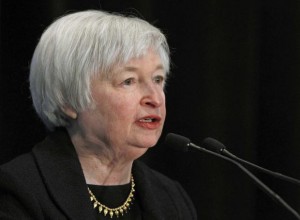
CREDIT: REUTERS/GARY CAMERON
(Reuters) – Federal Reserve Chair Janet Yellen said on Tuesday the U.S. central bank was on track to keep reducing its policy stimulus, even as she acknowledged the labor market recovery was “far from complete.”
In her first public comments as Fed chief, Yellen said the central bank would need to keep its eye on a broad range of labor market indicators, not just the unemployment rate, as it continued to assess the health of the jobs market.
Yellen, in testimony prepared for delivery to a congressional committee, nodded to the recent volatility in global financial markets, but said at this stage it does “not pose a substantial risk to the U.S. economic outlook.”
She emphasized continuity in the Fed’s policy strategy, saying she strongly supports the approach driven by her predecessor, Ben Bernanke. Under Bernanke, the Fed bought trillions of dollars worth of bonds to drive long-term borrowing costs lower. In December, it started to scale back its latest asset purchase program.
While the U.S. unemployment rate has fallen by 1.5 percentage points since the latest bond-buying program began in September of 2012, at 6.6 percent the rate remains “well above levels” the Fed sees as consistent with maximum sustainable employment, Yellen said.
“(T)he recovery in the labor market is far from complete,” she told the House Financial Services Committee.
Encouraged by momentum in the economy last year, the Fed has trimmed asset purchases twice since December; it now buys $65 billion in Treasuries and mortgage bonds each month.
Yellen said the Fed will “likely reduce the pace of asset purchases in further measured steps at future meetings” if economic data broadly supports policymakers’ expectation of improved labor markets and a rise in inflation.
She said, however, the purchases are not on a pre-set course, repeating the Fed’s policy line.
Prices for U.S. government bond fell and the dollar rose against the euro and the yen as investors digested Yellen’s comments. U.S. stock futures were up in volatile trade.
“It’s very obvious she is working from the same playbook as Bernanke,” said Tom Porcelli, chief U.S. economist at RBC Capital Markets in New York. “The Fed will continue cut its bond purchases by $10 billion at each policy meeting the rest of the year.”
EYE ON THE JOBS MARKET
Yellen, in just her second week on the job, cited the “unusually large fraction” of jobless Americans who have been out of work for more than six months, and the “very high” number of part-time workers who would prefer full-time jobs.
“These observations underscore the importance of considering more than the unemployment rate when evaluating the condition of the U.S. labor market,” she said.
The Fed has said it will not raise interest rates from near-zero until the jobless rate drops to at least 6.5 percent as long as inflation looks to remain under control. But with the jobless rate on the cusp of breaching this threshold, policymakers are considering how best to adjust their guidance.
More than five years after the 2007-2009 recession ended, the Fed has embarked on perhaps its most difficult policy shift as it tries to back away from flooding the financial system with ultra-easy money while at the same time convince investors that interest rates will stay near zero well into next year.
A shaky run of data has raised questions over whether the U.S. economy can sustain the strength it showed in the second half of last year. While the unemployment rate more than a percentage point over the past year, jobs growth slowed sharply in the last two months.
The weak U.S. jobs growth and a recent selloff in emerging markets that also hit Wall Street could complicate things for the Fed.
Yellen said the Fed was watching the recent market volatility closely.
“Our sense is that at this stage these developments do not pose a substantial risk to the U.S. economic outlook,” she added. “We will, of course, continue to monitor the situation.”
Noting inflation remains below the Fed’s 2 percent target, Yellen said “the recent softness reflects factors that seem likely to prove transitory, including falling prices for crude oil and declines in non-oil import prices.”
The Fed will not let inflation run “persistently above or below” its 2 percent goal, she added.
Long concerned with the pain the recession caused U.S. workers, Yellen is sometimes seen as more dovish than Bernanke and thus willing to do more to stimulate the economy even if inflation could eventually ramp up as a result.
Her prepared testimony on the Fed’s semiannual monetary policy report was released ahead of her appearance before the House committee, which is scheduled for 10 a.m. ET.
The committee’s chairman, Jeb Hensarling of Texas, is a long-standing critic of the aggressive Fed stimulus, which he argues has enabled a huge run-up in U.S. debt.
Republicans have signaled they want to press Yellen on what they see as the limited effectiveness, and even dangers, of a central bank balance sheet now worth $4 trillion and counting. Many Republicans worry the Fed’s largesse could let inflation get out of hand or fuel asset bubbles.








